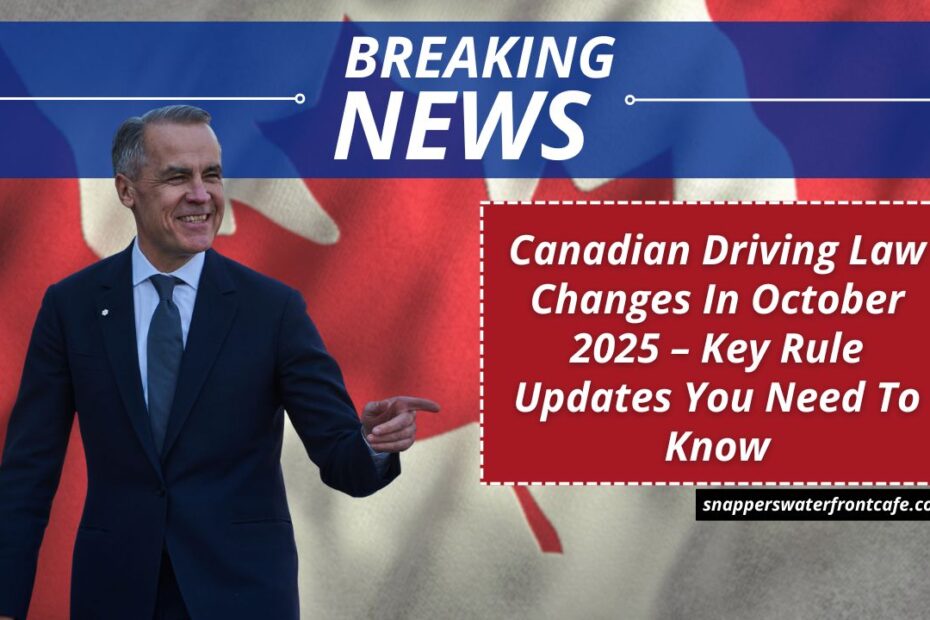Canada is preparing for a major regulatory shift on its roads starting October 2025. These new Canadian driving law changes will affect both new and experienced drivers.
The reforms introduce tougher enforcement, updated road rules, and higher penalties across several provinces.
The primary focus is on safety, accountability, and uniformity to ensure smoother traffic flow and fewer accidents.
Whether you drive daily, operate commercial vehicles, or only take occasional road trips, staying updated on these new regulations is essential.
Below, we break down the key updates and their impact on Canadian motorists.
Updated Speed Limits and Zone Rules
From October 1, 2025, municipalities in Ontario, Quebec, and British Columbia gain the authority to reduce residential speed limits to 30 km/h.
This move is designed to protect pedestrians and cyclists, especially in busy school zones.
While most highway speed limits will remain the same, photo radar enforcement will be extended into suburban and rural regions for stricter monitoring.
In Alberta, a significant change is being introduced: construction zone speed limits will now apply 24/7, not just when workers are present.
Drivers caught violating these limits risk instant license suspensions under the revised rules.
Key Speed Limit Updates
| Province | Main Speed Limit Changes | New Enforcement Rules |
|---|---|---|
| Ontario | 30 km/h in residential areas | Wider photo radar use |
| Alberta | Permanent reduced speeds in construction zones | On-the-spot license suspension |
| Quebec | Lower school zone speeds | Double fines during school hours |
Tighter DUI Rules and Advanced Testing
One of the most notable changes in Canadian driving laws October 2025 is the reduction of the legal Blood Alcohol Concentration (BAC) limit.
The nationwide threshold will now be 0.05%, replacing the previous 0.08% standard in certain provinces.
This move aligns Canada with international safety standards and is expected to significantly cut impaired driving incidents.
Enforcement tools are also getting a technological boost. Police across provinces will start using AI-powered breathalyzers and drug-screening devices.
These systems deliver faster and more accurate results, improving roadside enforcement.
Refusing to take a test will now result in a minimum $2,500 fine and a 90-day license suspension.
Changes to the Demerit Point System
The demerit point framework is undergoing a nationwide overhaul to ensure stricter accountability for repeat offenders. Offenses such as distracted driving, failing to yield, and speeding in safety zones will now carry higher point penalties.
- Drivers accumulating more than 10 points within 12 months must complete a mandatory driving education course.
- The focus is shifting toward rehabilitation over punishment. First-time violators may receive lighter penalties if they agree to complete a government-funded defensive driving program.
This change aims to make drivers more responsible while providing opportunities to relearn safe driving practices.
Parking and Idling Law Reforms
Several major Canadian cities, including Toronto, Vancouver, and Montreal, are introducing stricter idling rules. Vehicles left running for more than 60 seconds in normal weather conditions will face fines between $150 and $400.
The goal is to cut unnecessary emissions and improve air quality.
At the same time, illegal parking fines near bike lanes, crosswalks, and fire hydrants are increasing. Municipalities also plan to enforce towing more aggressively, particularly during peak traffic hours.
What These Updates Mean for Drivers
These new traffic law changes are more than just penalties—they represent a cultural shift toward safer, more responsible driving.
By lowering speed limits, tightening DUI rules, and modernizing enforcement, the Canadian government is working to reduce road accidents and protect vulnerable road users.
For everyday drivers, this means even minor infractions can carry serious consequences.
Regular commuters, delivery drivers, and even occasional motorists should take time to review the new rules before October 2025 to avoid costly fines or suspensions.
The Canadian driving law changes October 2025 bring significant adjustments aimed at making roads safer for all. With lower residential speed limits, stricter BAC thresholds, harsher penalties for repeat offenders, and tighter parking regulations, drivers will need to adapt quickly.
These reforms emphasize safety first, ensuring that Canada’s roads remain secure and efficient. For drivers, staying informed isn’t just recommended—it’s essential.
Frequently Asked Questions
What is the new legal BAC limit in Canada from October 2025?
The nationwide Blood Alcohol Concentration (BAC) limit will be 0.05%, making impaired driving penalties stricter than before.
Will G1 and G2 license holders be affected by these changes?
Yes. Novice drivers under G1 and G2 licenses will face tougher consequences under the updated demerit point system.
Are the new residential speed limits permanent?
Municipalities will have the authority to decide long-term enforcement. Many areas are expected to keep the reduced limits permanently if they show improved safety outcomes.
